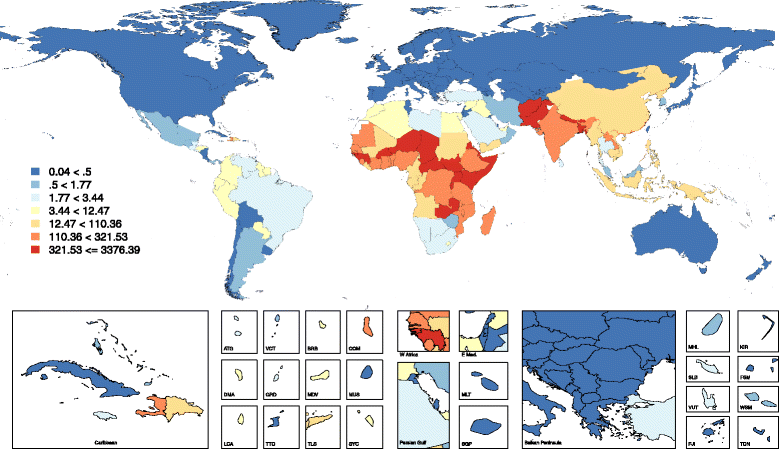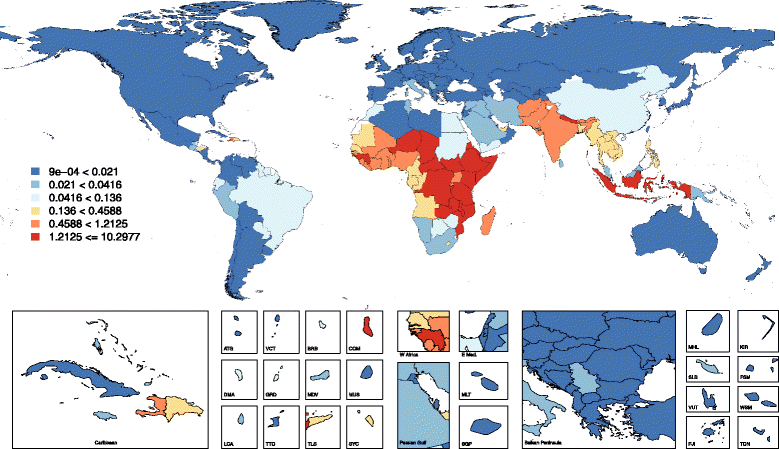Mortality from tetanus between 1990 and 2015: findings from the global burden of disease study 2015
- PMID: 28178973
- PMCID: PMC5299674
- DOI: 10.1186/s12889-017-4111-4
Mortality from tetanus between 1990 and 2015: findings from the global burden of disease study 2015
Abstract
Background: Although preventable, tetanus still claims tens of thousands of deaths each year. The patterns and distribution of mortality from tetanus have not been well characterized. We identified the global, regional, and national levels and trends of mortality from neonatal and non-neonatal tetanus based on the results from the Global Burden of Disease Study 2015.
Methods: Data from vital registration, verbal autopsy studies and mortality surveillance data covering 12,534 site-years from 1980 to 2014 were used. Mortality from tetanus was estimated using the Cause of Death Ensemble modeling strategy.
Results: There were 56,743 (95% uncertainty interval (UI): 48,199 to 80,042) deaths due to tetanus in 2015; 19,937 (UI: 17,021 to 23,467) deaths occurred in neonates; and 36,806 (UI: 29,452 to 61,481) deaths occurred in older children and adults. Of the 19,937 neonatal tetanus deaths, 45% of deaths occurred in South Asia, and 44% in Sub-Saharan Africa. Of the 36,806 deaths after the neonatal period, 47% of deaths occurred in South Asia, 36% in sub-Saharan Africa, and 12% in Southeast Asia. Between 1990 and 2015, the global mortality rate due to neonatal tetanus dropped by 90% and that due to non-neonatal tetanus dropped by 81%. However, tetanus mortality rates were still high in a number of countries in 2015. The highest rates of neonatal tetanus mortality (more than 1,000 deaths per 100,000 population) were observed in Somalia, South Sudan, Afghanistan, and Kenya. The highest rates of mortality from tetanus after the neonatal period (more than 5 deaths per 100,000 population) were observed in Somalia, South Sudan, and Kenya.
Conclusions: Though there have been tremendous strides globally in reducing the burden of tetanus, tens of thousands of unnecessary deaths from tetanus could be prevented each year by an already available inexpensive and effective vaccine. Availability of more high quality data could help narrow the uncertainty of tetanus mortality estimates.
Keywords: Distribution; Mortality; Tetanus; Trends.
Figures
References
-
- Frick L, Frey R. “Tetanus.” Gale Encyclopedia of Alternative Medicine. 2005. [May 22, 2015]. Available from: http://www.encyclopedia.com/doc/1G2-3435100772.html
-
- World Health Organization. Viet Nam eliminates maternal and neonatal tetanus [May 22, 2015]. Available from: http://www.who.int/mediacentre/news/releases/2006/pr10/en/.
-
- United Nations Children’s Fund (UNICEF). Eliminating maternal and neonatal tetanus. Available from: http://www.who.int/immunization/diseases/UNICEF_MNT_Advocacy_June04.pdf.
MeSH terms
LinkOut - more resources
Full Text Sources
Other Literature Sources
Medical




